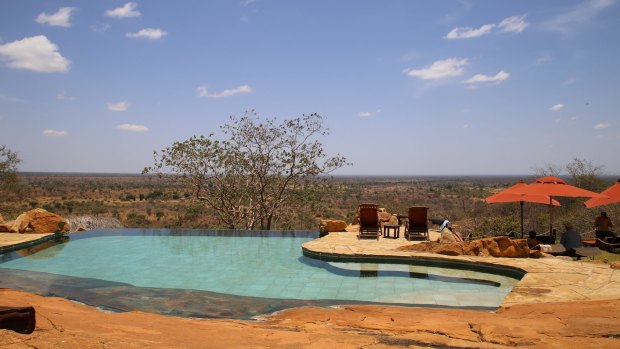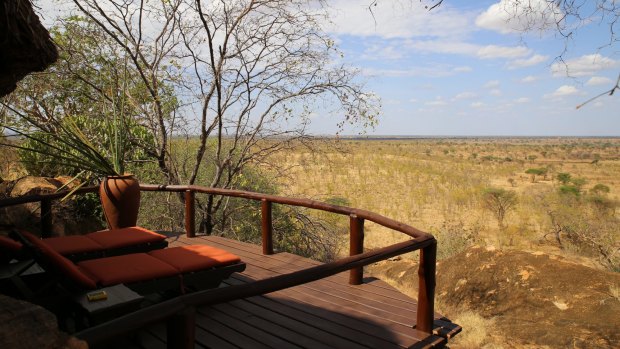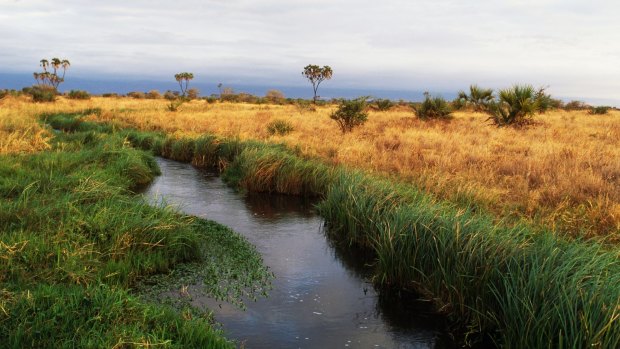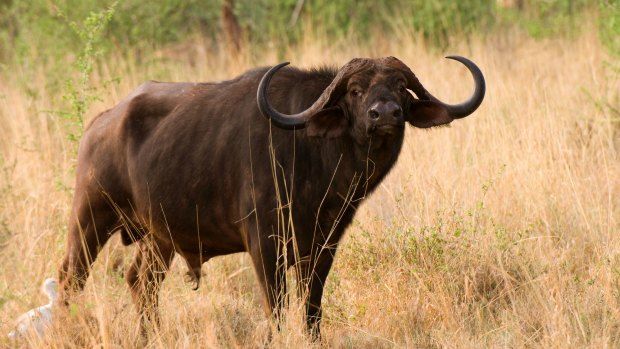This was published 6 years ago
Meru National Park, Kenyan: The sanctuary where wildlife become your roommates

Pool at Elsa’s Kopje.Credit: Ben Groundwater
There's wildlife in my bathroom. I just saw a tiny face peering out at me from next to the basin. There was a flash of fur when I walked in the door.
You don't have to go too far to find animals at Meru National Park, in northern Kenya. From my bungalow at Elsa's Kopje, the main lodge here, I could wander out to the balcony and view the full splendour of the park: the giraffes stalking the horizon like cranes on a city skyline; the herds of zebra grazing the savannah; the birds of prey stalking from high above. Or, I could go into the bathroom and see what's scurrying around in there.
This is what happens when your bungalow has no proper walls, when you commune with nature in the best possible way. Occasionally, nature wanders inside.

A deck at Elsa’s Kopje.Credit: Ben Groundwater
The little guy huddled under my bathroom sink is a rock dassie, a harmless herbivore that is Africa's answer to the guinea pig. There are plenty around here on the "kopje" – the Afrikaans word for a rocky outcrop – large groups of dassies sunning themselves on rocks, or munching on leaves in the trees, so it's no surprise to find that one got curious while I was out on safari this morning and popped in to check out my bungalow.
It's pretty nice in here, after all. There's a four-poster bed draped in lace – or, as they call it around here, mosquito netting. There's that large balcony with its views across the acacia-dotted bush land that makes up Meru. There are walls that zip open to blur the lines between dwelling and destination. And there is the large bathroom that is playing hosting a guest.
Of course, you don't come to Meru for the accommodation; not really, anyway. You come here for the safari experience, for the feeling of being in the true African wild. It takes a full day of driving to get from the Kenyan capital, Nairobi, to Meru National Park, a journey that takes you from the bustle of the big city and out into Kenya proper, past pineapple plantations and over lush, rolling hills, before the towns become smaller, and finally you enter the park itself.

A river in Meru National Park, Kenya. Credit: Getty Images
This is not one of Kenya's more popular safari destinations, mostly due to its remote location and its lack of Masai Mara cachet, but that's good news, really: roaming around here on the lookout for wildlife, you rarely see another car. Rarely another person. What you do see, however, are animals.
Those animals tell stories, too, as my guide, Kyle Ray, explains. With so few people around here, with so few outside influences, you get the time and the space while on safari to interpret their movements, to understand the tale that the bush is trying to tell.
One night we're sitting around the dinner table at Elsa's Kopje when Kyle grips my arm and motions to the air. "You hear that?" he says. "The frogs just started going crazy. That means there's probably a snake around."

Cape Buffalo, Meru National Park, Kenya.Credit: Getty Images
Good to know. And when you see impala – those slim, graceful antelopes – running through the bush for what seems like no reason … there is always a reason. "Probably a lion close by," Kyle says one morning, scanning the bush. Sure enough, we spot the telltale tawny fur a few hundred metres away. "If you see vultures circling in the air later, then it's made its kill," Kyle says.
There are other stories to learn here, too, stories that are more conventional and human. Elsa's Kopje, it turns out, was named after Elsa the Lioness, one of four lion cubs adopted and raised by George Adamson and his wife Joy in this park in the 1950s. Joy Adamson's book about that experience, Born Free, brought Meru and animal conservation to the world's attention.
You can see what drew them to this place too, and what kept them here. There is a romance to the bare savannah of Meru, to the red dirt and the blue skies, to the animals that roam freely. There's beauty in the stories, though sometimes quite savage, that this place has to tell.
Meru has one final yarn. As dusk approaches one evening, and Kyle and I are returning to the kopje after an afternoon game-drive, we spot martial eagles circling high above the lodge. Kyle fixes his binoculars on them. "Probably hunting rock dassies," he says.
I nod, before it clicks. Rock dassies! Those are my roommates. My friends. I can only hope they've taken shelter in the bathroom.
TRIP NOTES
MORE
FLY
Emirates Airline flies from Australian ports to Nairobi, via Dubai. See emirates.com
STAY
The Classic Safari Company offers stays at Elsa's Kopje as part of its 10-day Classic Kenya Road Safari. Packages, including accommodation, transfers, meals and guided game viewing, start from $US6200 a person. See classicsafaricompany.com.au
Ben Groundwater travelled as a guest of the Classic Safari Company.
Sign up for the Traveller Deals newsletter
Get exclusive travel deals delivered straight to your inbox. Sign up now.